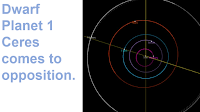Comet 364P/PANSTARRS passed by the Earth at a distance of 18 056 000 km (12% of the distance between the Earth and the Sun), slightly after 7.20 pm GMT on Friday 7 April 2023. At this distance it is not naked eye visible, but should be observable by amateur astronomers armed with small telescopes or binoculars with apertures greater than 80 mm, in the constellation of Vulpecula, which is best seen from the Northern Hemisphere.
Comet 364P/PANSTARRS was discovered on 6 August 2014 by the the University of Hawaii's PANSTARRS telescope. The name 364P/PANSTARRS implies that it is a Periodic Comet (P/), that it was the 364th such body discovered, and that it was discovered by the PANSTARRS telescope.
Comet 364P/PANSTARRS has an orbital period of 1783 days (4.88 years) and a highly eccentric orbit tilted at an angle of 12.15° to the plain of the Solar System, that brings it from 0.80 AU from the Sun at closest perihelion (80% of the distance between the Earth and the Sun) to 4.96 AU from the Sun at aphelion (4.96 times as far from the Sun as the Earth or slightly inside the orbit of the planet Jupiter). As a comet with a period of less than 20 years, 364P/PANSTARRS is considered to be a Jupiter Family Comet.
This means that 364P/PANSTARRS has occasional close encounters with the Earth, with the last thought to have happened in July 2018 and the next predicted in March 2028. The comet also has occasional close encounters with the planets Venus, which it last came close to in October 2003 and is next predicted to pass in October 2155, Mars which it is next predicted to pass in August 2135, and Jupiter, which it last came close to in January 2001 and is expected to pass again in September 2024. Objects which make close passes to multiple planets are considered to be in unstable orbits, and are often eventually knocked out of these orbits by these encounters, either being knocked onto a new, more stable orbit, dropped into the Sun, knocked out of the Solar System or occasionally colliding with a planet.
See also...
Follow Sciency Thoughts on Facebook.
Follow Sciency Thoughts on Twitter.


.jpg)





